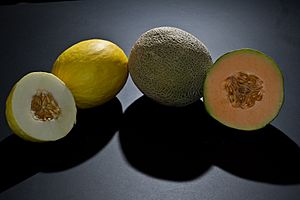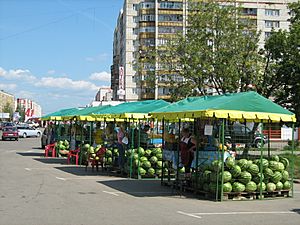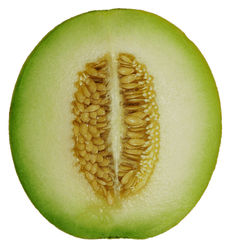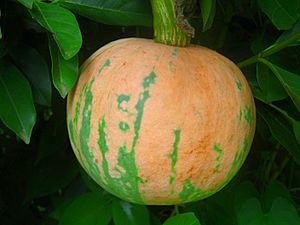Melon facts for kids


A melon is a type of sweet, juicy fruit that grows on a vine. Most melons have a soft, fleshy inside that you can eat. They belong to a plant family called Cucurbitaceae. While melons are technically fruits, some kinds are often used in cooking like vegetables.
Many popular melons, like the muskmelon, belong to the Cucumis plant group. The juicy watermelon belongs to a different group called Citrullus. The word melon comes from an old Latin word, melopepo, which means "apple-gourd."
Contents
History of Melons
Melons first grew in Africa and Western Asia. Over time, they slowly made their way to Europe around the end of the Roman Empire.
When early settlers came to America, they brought melons with them. People were growing types like honeydew and casaba melons as early as the 1600s. Some Native American groups in New Mexico even developed their own special kinds of melons. These came from the melons first brought by the Spanish.
Why Melons Are Good For You

Melons are a very healthy food! They are full of water, which helps keep your body hydrated. This also means they can help your body get rid of extra water.
Cantaloupes are especially good for your heart. They have a lot of potassium, which can help people with high blood pressure.
Scientists have also found that melons contain something called lycopene. This is a special helper that can protect your body's cells. Eating melons might even help lower the risk of certain diseases.
Different Kinds of Melons
Benincasa Melons
- Winter melon (B. hispida) is the only melon in the Benincasa group. When it's fully grown, it's used as a cooking vegetable, especially in Asia and India. Younger winter melons can be used to make a special fruit drink.
Citrullus Melons
- Egusi (C. lanatus) is a wild melon that looks a bit like a watermelon. You can't eat its flesh, but its seeds are a very important food source in Africa.
- Watermelon (C. lanatus) first came from Africa. People have been growing watermelons for over 4,000 years! It's a very popular summer fruit all around the world.
Cucumis Melons
Most of the melons we eat belong to the Cucumis group, especially the species Cucumis melo L..
- Horned melon (C. metuliferus) is an African plant with cool, spiky skin. It's now grown in places like California and Australia.
- Muskmelon (C. melo) is a large group with many different types:
- C. melo cantalupensis has rough, bumpy skin that isn't netted.
- The European cantaloupe has light green, slightly ribbed skin. It was first grown in Italy in the 1700s. In Australia and New Zealand, it's called a 'rockmelon'.
- The Persian melon looks like a big cantaloupe but has darker green skin and a finer net pattern.
- C. melo inodorus includes casabas, honeydews, and Asian melons.
- Canary melon is a large, bright-yellow melon with pale green or white flesh inside.
- Casaba melons are bright yellow with smooth, grooved skin. They don't have as much flavor as some other melons but last longer.
- Hami melon comes from Hami, Xinjiang, China. Its flesh is sweet and crunchy.
- C. melo cantalupensis has rough, bumpy skin that isn't netted.
Honeydew melons have sweet, juicy, green-colored flesh. There's also a yellow-skinned variety with white flesh that tastes like a moist pear.
-
-
- Kolkhoznitsa melon has smooth, yellow skin and dense, white flesh.
- Korean melon is yellow with white lines and white inside. It can be crisp or juicy depending on how long it ripens.
- Piel de Sapo (which means "toad skin") or Santa Claus melon has blotchy green skin and sweet white flesh.
- C. melo reticulatus are the true muskmelons, with skin that looks like a net.
- North American cantaloupe is different from the European type. It has the net-like skin that is common for these melons.
- Galia (or Ogen) melons are small and very juicy, with light green or pinkish flesh.
-
Images for kids
-
Painted green melons in Chennai, India, 2010.




